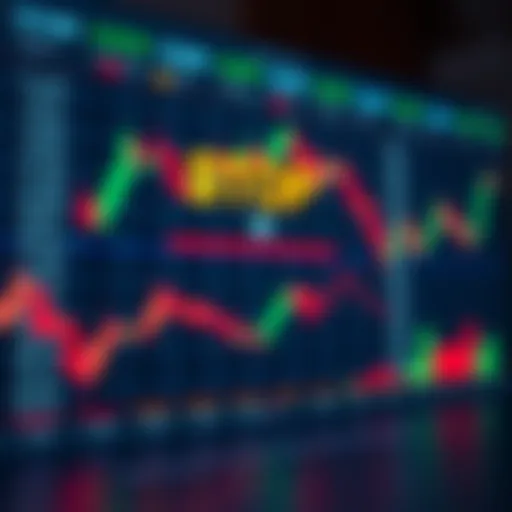Understanding USD to INR Conversion Rates and Trends


Intro
Currency conversion is an everyday affair for many people, including travelers and investors. When dealing with international funds, specifically the conversion from United States Dollars (USD) to Indian Rupees (INR), understanding the underlying factors and trends is crucial. It’s not just about the numbers; it’s about the implications those numbers hold in a tech-obsessed and globalized landscape. This journey begins with a dive into the market analysis, detailing current trends that shape this currency pair.
Market Analysis
The interaction between USD and INR isn’t one-dimensional; it’s influenced by both local and global dynamics. As economies shift, understanding the conversion rate becomes pivotal.
Current Trends in the Cryptocurrency Market
Cryptocurrency is not just a passing trend. With increasing acceptance, it's imperative to observe how it relates to traditional currencies like the USD and INR.
- The introduction of stablecoins ties cryptocurrencies to the US Dollar, providing a digital inflation hedge.
- Fluctuations in Bitcoin and Ethereum often trigger movements in conventional currencies, primarily due to the rapid and widespread adoption of digital assets.
- As of late, discussions surrounding CBDCs (Central Bank Digital Currencies) are heating up, altering the conversion landscape further.
This intersection creates a complex web. The fluctuations in crypto can directly or indirectly affect how investors view the USD to INR conversion rates. For example, a significant drop in crypto market value can result in capital outflows from digital assets, which may initially boost the Dollar against the Rupee due to heightened demand.
Price Prediction Techniques
Predicting exchange rates, especially for cryptocurrencies, involves both art and science. A few techniques prevail in the market:
- Fundamental Analysis: Examining economic indicators like inflation rates, interest rates, and economic stability in both the US and India can provide insights into future currency movements.
- Technical Analysis: Utilizing charts and historical data, traders can identify patterns that might indicate future trends. A common method is the use of moving averages to understand price direction.
- Sentiment Analysis: The ever-changing market sentiment, often examined through social media trends and news articles, can give a picture of investor confidence, which invariably affects conversion rates.
"The currency markets are a reflection of the broader economic landscape. Understanding the interconnectedness of currencies, commodities, and cryptocurrencies shows how larger forces shape exchange rates."
In summary, awareness of the current market dynamics and price prediction techniques is foundational for anyone delving into the economics of USD to INR conversion. By grasping these elements, investors, traders, and tech enthusiasts can navigate the complexities of global currency exchanges more successfully.
Preface
When it comes to engaging with the financial world, understanding currency conversion holds a significant place. It serves as a foundational aspect of global trade, international investments, and travel plans. In this article, a spotlight is cast on converting United States Dollars to Indian Rupees, an important journey for investors, traders, and travelers alike.
Knowing how to convert 1 USD to INR is not just about numbers; it's about comprehending systemic factors that drive currency fluctuations. A well-informed investor or traveler can dramatically optimize financial strategies by grasping these dynamics. Take, for example, a trader looking to invest in emerging markets: understanding the nuances of currency conversion can set the stage for accurate pricing, risk assessment, and strategic decision-making.
Furthermore, the importance of currency conversion transcends mere academic interest; it's vital for maximizing the value of your funds. Whether it’s for everyday transactions or large investments, capitalizing on favorable exchange rates can benefit your overall financial portfolio.
"Currency is the lifeblood of international trade, making its conversion essential for any serious investor or traveler."
Beyond the fundamentals, we delve into the overview of USD and INR dynamics, unraveling the threads that connect these two currencies. Together, these insights will help readers understand not only the current state of affairs but also historical trends and what potential future shifts might entail.
Historical Perspective
Understanding the historical perspective of the USD to INR conversion is key for investors, traders, and anyone involved in cross-border transactions. The fluctuations in exchange rates are not merely numbers; they embody economic policies, geopolitical events, and global financial sentiments. Grasping these factors allows stakeholders to make informed decisions, whether they are sending money abroad, investing in foreign stocks, or planning travels. By analyzing past trends and the underlying reasons for their movements, it becomes easier to predict future behaviors of the currency pair.
USD to INR Conversion Trends
Over the past few decades, the USD to INR conversion rate has experienced considerable volatility.
- In the early 1990s, the rupee was pegged at around 17 to 20 per dollar. As economic reforms rolled out in 1991, the rupee was allowed to float, leading to significant depreciation.
- By 2000, the rate hovered around 43.5, signaling an era of liberalization and foreign investment into India.
- Fast forward to 2013, where the rupee hit a historic low of about 68 to 69 against the dollar, primarily influenced by a mix of rising oil prices and concerns regarding India's current account deficit.
- In recent years, the exchange rate has stabilized between 70 and 75, attributed to the Reserve Bank of India's consistent monetary policies and a more balanced trade situation.
Such trends highlight how external and internal economic factors have contributed to the currency's strength or weakness over time. Understanding these shifts is vital for formulating investment strategies and planning for potential risks in the currency markets.
Factors Influencing Historical Fluctuations
Several key factors have shaped the historical fluctuations of the USD to INR exchange rate:
- Inflation Rates: Higher inflation in India compared to the U.S. often leads to a weaker rupee. When the cost of goods and services rises significantly, it erodes purchasing power, influencing the currency's value against the dollar.
- Economic Policies: Changes in monetary policy by the Reserve Bank of India and the Federal Reserve have a profound impact. For instance, when the Fed raises interest rates, it often strengthens the dollar, resulting in a weaker rupee.
- Global Financial Crises: Events like the 2008 financial crisis and the COVID-19 pandemic have caused significant disruptions in currency markets. During these times, investors typically seek refuge in currencies perceived as more stable, such as the dollar, leading to further depreciation of the INR.
- Trade Deficits: A persistent trade deficit can weaken a country's currency. If India imports more than it exports, it leads to increased demand for foreign currencies to pay for goods, applying downward pressure on the rupee.
- Investment Flows: Foreign Direct Investment (FDI) and Foreign Portfolio Investment (FPI) can also affect the exchange rate. Inflows typically strengthen the rupee, while outflows can lead to its depreciation.
Current Exchange Rate Analysis
The examination of the current exchange rate between the United States Dollar (USD) and the Indian Rupee (INR) is crucial for various stakeholders. Investors, traders, and analysts depend heavily on this data to make informed decisions. The present exchange rate is not merely a number but a reflection of market sentiments, economic conditions, and geopolitical factors that intertwine to shape the financial landscape.
Present Market Rates
As of the latest data, the conversion rate fluctuates around 82 INR for 1 USD. Such values can be subject to rapid changes based on several factors, including market demand, investor sentiment, and international relations. Understanding this rate serves as the first step for anyone engaging in cross-border transactions.


To see how these rates impact different actors:
- Travelers may find this rate influences their spending ability when traveling from the U.S. to India.
- Businesses involved in imports or exports between the U.S. and India must navigate this currency landscape to manage profit margins effectively.
- Investors should track these rates for better timing in making investments in Indian markets or assets.
"Currency doesn’t just tell you how much something costs; it speaks volumes about the nation’s economy and its health."
Also, one must consider how off-the-clock fluctuations can lead to different prices in various contexts. For instance, if a traveler checks rates at one bank and then at another, they may find discrepancies due to differing source information.
Impact of Global Market Trends
The pulse of global markets heavily influences the USD to INR conversion rates. Various elements can shift this relationship, often causing unexpected ripples.
- Interest Rate Announcements from the Federal Reserve or India's Reserve Bank can signal major changes in corresponding currencies, creating waves in forex markets.
- Geopolitical Events, such as trade agreements or tensions, can also lead to significant fluctuations. For instance, a trade deal between the U.S. and India can bolster the rupee against the dollar, as it indicates stronger economic collaboration.
- Economic Performance Indicators, such as GDP growth rate or unemployment figures, serve as vital signals. A stronger economic outlook in India compared to the U.S. can also make the INR more favorable.
In summary, keeping an eye on market trends helps investors and traders implement strategies that align with currency performance, thereby optimizing their financial outcomes. It’s equally essential for travelers to plan their budgets based on anticipated trends to get the best bang for their buck when converting currencies.
Economic Factors Impacting Conversion Rates
Understanding the economic factors influencing currency conversion rates is crucial for making informed decisions in both investment and travel. The relationship between the United States Dollar (USD) and the Indian Rupee (INR) doesn’t exist in a vacuum; it is significantly affected by various economic indicators and market dynamics. From inflation rates to interest rates, each element plays a vital role in shaping how one currency is valued against another. Investors, traders, and analysts should grasp these concepts as they navigate a complex financial landscape.
Inflation Rates in the USA and India
Inflation rates are a primary driver of currency value and purchasing power. In the US, when inflation rises, the purchasing power of the USD decreases, often forcing the Federal Reserve to adapt its monetary policy. Conversely, when inflation is contained, the USD typically maintains its strength in foreign exchange markets.
In India, the scenario unfolds similarly, although the dynamics can differ due to various structural factors in the economy. For instance, higher inflation in India may lead to a depreciation of the INR against the USD, thus making imports more expensive and affecting the current account deficit.
"Inflation is not just about rising prices; it directly impacts currency valuations and economic health."
To better comprehend the implications of inflation:
- It reduces the real returns on investments made in that currency.
- It influences central banking policies that can either tighten or loosen monetary supply.
- It affects consumer behavior, impacting overall economic growth.
Understanding these dynamics can provide investors with foresight on potential currency valuations.
Interest Rate Variations
Interest rates are another critical economic factor that influences the currency conversion rates between USD and INR. When the Federal Reserve increases rates, it often attracts foreign investment into US assets, raising the USD's value. This is because higher interest rates provide better returns on investments denominated in USD.
On the other side, if the Reserve Bank of India raises interest rates to combat inflation, it can strengthen the INR similarly. However, the interplay between these two central banks is complex. An increase in interest rates in the US could overshadow that of India, leading to a stronger USD relative to the INR.
Some key points to consider:
- A higher interest rate typically leads to higher foreign capital inflow.
- The expectations of future interest rates often drive market movements.
- Exchange rates reflect differential interest rates between two countries.
Trade Balances and Current Accounts
Trade balances are fundamental in understanding how currencies interact with one another. A country with a trade surplus sells more goods abroad than it imports, leading to a stronger currency due to higher demand. Conversely, a trade deficit can weaken a currency as more foreign exchange is required to pay for imports.
For example, if India has a robust demand for US technology or agricultural products, it might lead to an increased flow of INR to the US in exchange for goods, potentially strengthening the USD against the INR.
The current account, which includes the trade balance as well as net income and current transfers, paints a broader picture:
- A surplus generally strengthens the domestic currency.
- A deficit can indicate underlying economic issues that might weaken a currency.
In summary, the relationship between these economic variables forms the backbone of currency conversion rates. Understanding inflation, interest rates, and trade balances helps both investors and travelers make informed choices regarding their financial strategies and decisions.
Impact on Investors and Traders
When it comes to the conversion of United States Dollars to Indian Rupees, understanding the implications is invaluable for both investors and traders. Exchange rates can drastically influence investment decisions, and currency fluctuations present a unique set of opportunities and risks. In particular, savvy investors can leverage these shifts to optimize their portfolios or even diversify their assets. Additionally, traders who keep their finger on the pulse of exchange movements can capitalize on price discrepancies in different markets.
Investment Strategies in a Volatile Market
Navigating the often turbulent waters of foreign exchange necessitates a clear strategy. One prudent approach for investors is to employ hedging techniques. Hedging involves taking offsetting positions to mitigate potential losses. For example, an investor holding assets denominated in INR may choose to purchase a USD/INR futures contract to guard against depreciation of the rupee.


Moreover, it is wise to keep an eye on fundamental indicators that impact currency values such as inflation, trade balances, and political stability. A comprehensive understanding of these factors helps to develop a more nuanced viewpoint.
An additional strategy is the use of stop-loss orders. This mechanism allows traders to specify a point at which they wish to automatically exit a position, limiting their losses if the market moves unfavorably. This leads to a more disciplined approach to trading, preventing emotional decisions that can arise during high-stress situations.
Prioritizing risk management is key here. Investors should assess their risk tolerance against the volatility in currency markets, understanding that higher returns often come with increased risk. As such, a balanced view incorporating both aggressive and conservative techniques can be the linchpin to success in this arena.
Implications for Cryptocurrency Investments
In the wake of the growing popularity of cryptocurrencies, the relationship between fiat currencies such as the USD and INR becomes ever more complex. For investors delving into digital currencies, understanding how fluctuations in the USD to INR conversion rate can affect potential profits is crucial. For instance, a cryptocurrency priced in USD may appear to have different value propositions as the Indian rupee shifts downward against the dollar.
Current trends indicate that, as the INR weakens, purchasing power diminshes for Indian investors looking to buy cryptocurrencies. This decrease can lead to a situation where investors in India may be less likely to enter the digital asset market, subsequently affecting overall demand.
Investors should also be mindful of potential regulatory changes that impact cryptocurrency exchanges operating in India. These regulations can vary widely from country to country, leading to discrepancies in trading volumes and practices. Furthermore, fluctuations in exchange rates might alter the pricing mechanisms for these cryptocurrencies, compounding the risks further.
In summary, the integration of currency conversion dynamics into the investment consideration for cryptocurrencies is essential. It enables traders and investors to craft more informed strategies that align with the broader global economic landscape.
"Only those who risk going too far can possibly find out how far one can go."
– T.S. Eliot
Understanding the nuances of the USD to INR conversion not only aids in initial investment considerations but also allows for a holistic approach to navigating both traditional and digital investment landscapes.
Currency Conversion Fees and Charges
Currency conversion fees and charges may seem like a minor detail when trading currency or planning a trip, but they can significantly affect your budget and investment returns over time. Understanding these fees is essential for both travelers and investors, as they directly impact the net amount received when converting currencies. This section delves into the intricacies of currency conversion fees and highlights critical aspects that can save you money or enhance your investment strategies.
Understanding Exchange Fees
Exchange fees are the costs you incur when converting USD to INR or any other currency. They can vary based on the method you choose for conversion. These fees can come in various forms, including:
- Flat fees: This is a set charge that applies regardless of the amount being exchanged.
- Percentage fees: This percentage is deducted based on the total amount being converted. A 2% fee on $1,000 means you would pay $20 simply for the service.
- Hidden fees: These are costs embedded within less obvious rates, such as unfavorable exchange rates that don't appear until the transaction is completed.
When planning a transaction, it’s crucial to uncover the full extent of these charges. For instance, some currency exchange services, like airports, may provide a convenient option but with much higher fees. You might get a more favorable rate at a bank, but it’s important to check their charges first.
"Factors influencing your choice of currency exchange can ultimately transform your travel experience or investment success.
Comparative Analysis of Banks and Apps
The landscape for currency conversion has evolved dramatically in recent years, thanks to the rise of financial apps and online services. This comparative analysis examines how traditional banks stack up against modern financial applications in terms of conversion fees.
Banks
When you step into a bank, you might expect a secure and traditional means of exchanging currency. However, many banks apply higher fees compared to digital platforms. While they often guarantee a fixed rate for international transfers, they might charge a premium that can lead to a significant hit to your finances. Banks generally offer the following:
- Robust customer service: In-person support can be beneficial, especially for large amounts.
- In-depth advice: Bank representatives can provide broader financial guidance, making them helpful for more than just simple conversions.
Apps
In contrast, currency conversion apps such as Wise or Revolut typically offer lower fees and more transparent pricing structures. You may find:
- Lower rates: These apps often use real-time exchange rates, cutting out the markup that banks keep.
- Convenience: Many apps allow users to exchange currencies at any time with just a few taps on their smartphones.
- Flexibility: You can convert various amounts without the constraints usually present in banks.
Risks Associated with Currency Fluctuations
Understanding currency fluctuations offers insights into both opportunities and pitfalls that come with trading and investing. Currency pairs, such as USD to INR, can experience significant volatility due to a range of influences. This is crucial for investors and traders, as these fluctuations directly affect the value of investments and purchasing power.
For investors engaged with international markets, the inherent risks associated with currency fluctuations cannot be overlooked. Currency volatility affects not only the potential returns on investments but also impacts the cost and feasibility of trading across borders. Given how economies are interconnected, even slight changes in exchange rates can ripple through portfolios, altering bottom lines and strategic plans.
Volatility and Its Effects
When talking about volatility in the context of currency exchange, picture a ship caught in tumultuous waters. The waves, representing market forces, can lift or drag down the vessel—much like the exchange rate can fluctuate based on numerous factors. These fluctuations can be unpredictable and sudden, influenced by:
- Political events: Elections, government policies, and political instability can create uncertainty, often leading to rapid changes in exchange rates.
- Economic data releases: Key indicators such as employment rates, GDP growth, and inflation reports can sway currency values in unexpected directions.
- Market sentiment: The perception of market participants, driven by news and speculation, can cause immediate reactions, pushing currencies up or down.
For instance, if the Indian government announces a major economic reform, the INR may strengthen against the USD, affecting all businesses that depend on such financial metrics. Understanding these dynamics is crucial, as investors must consider how interchangeable the dollar is with the rupee and what potential impacts may follow.


Mitigation Strategies for Investors
Given the unpredictability inherent to currency fluctuations, it is paramount to develop strategies that mitigate these risks. Here are some practical approaches:
- Hedging: Utilizing financial instruments like options or futures contracts can protect against adverse movements in exchange rates. For example, if an investor expects the INR to weaken, they might enter into a contract that locks in the current rate, minimizing potential losses.
- Diversification: Spreading investments across multiple currencies can alleviate risks. If one currency falters, others may rise and balance the overall portfolio.
- Regular Monitoring: Staying updated with global economic news and currency trends can give investors an edge. For instance, by tracking the responses of various economies to external stimuli, traders can make informed decisions to maximize profits and minimize losses.
- Using Currency ETFs: Investing in currency exchange-traded funds can be a viable option. This allows investors to hedge against currency risks with managed exposure without needing to trade directly in foreign currencies.
"Managing currency risk is akin to steering your ship through stormy seas. Knowing when to change course makes all the difference."
By keeping these strategies in mind, investors can navigate the tumultuous waters of currency trading with greater confidence. Currency fluctuations are not just numbers; they're a reflection of global economic health, and understanding their risks is vital for securing financial stability.
Future Outlook
The future outlook of the USD to INR conversion rate holds profound significance, particularly when considering its implications for varied sectors, including finance, trade, and tourism. With the global economy continually evolving, understanding future trends is essential for stakeholders seeking to navigate this complex landscape. This section will delve into predicted trends in currency exchange as well as the potential global economic factors that may influence the USD to INR exchange rate.
Predicted Trends in Currency Exchange
Anticipating the future movements in currency exchange rates necessitates one to analyze a mix of historical data and emerging patterns. The USD/INR rate has displayed volatility in the past, and it is likely that this trend will continue. Expecting fluctuations can be challenging, yet several indicators might give us a clue.
- Strength of the US Dollar: The US dollar is often seen as a safe haven, and its strength is influenced by interest rates and economic data. A robust dollar could lead to a higher value against the INR.
- Economic Growth in India: India's economic growth trajectory will significantly impact its currency valuation. A thriving economy may buoy the INR, making it stronger against the dollar.
- Global Economic Events: Natural disasters, political instability, and global market sentiment can quickly send ripples through exchange rates. For instance, geopolitical tensions can create uncertainty, leading investors to favor the dollar.
In summary, while predicting exact numbers can be precarious, understanding these elements can help investors and analysts gauge potential movements in the currency pair.
Potential Global Economic Factors
Several macroeconomic elements can greatly influence the USD to INR conversion rates. Keeping abreast of these factors is crucial for investors and traders as they lay the foundation for market predictions.
- Inflation Trends: Inflation in both the US and India must be monitored closely. An uptick in inflation generally erodes a currency's purchasing power, thereby affecting conversion rates.
- Central Bank Policies: Decisions by the Reserve Bank of India or the US Federal Reserve can alter liquidity in the market. For instance, rate hikes in the US often attract foreign capital, increasing demand for dollars and impacting the INR exchange rate.
- Global Trade Dynamics: Changes in trade agreements or tariffs can affect economic partnerships, altering demand for respective currencies. A favorable balance of trade for India might strengthen the INR against the dollar.
- Investor Sentiment: Decisions made by institutional investors can sway currency values. If a large influx of capital comes into Indian markets, it can support the INR.
Ultimately, the currency conversion landscape is fraught with variables that require diligent observation. A keen grasp of these global economic factors provides a strategic advantage for stakeholders involved in currency exchange.
Practical Usage for Travelers
In the world of travel, understanding the conversion of currencies can make or break the experience. When you decide to venture into India with your hard-earned USD, it's paramount to grasp how the USD to INR conversion impacts your spending power. It’s not just about getting the best rates; it’s also about timing, fees, and how to stretch your dollar to suit your travel plans.
Navigating this conversion is crucial for planning your travel budget. An overestimation of the dollar’s value could leave you in a pinch, while an underestimation might lead to unnecessary stress on your trip. Additionally, knowing how to effectively exchange currency can save you from being short-changed by unfavorable rates offered at airports or hotels, where costs can skyrocket.
Best Practices for Currency Exchange
To optimize your currency exchange process, consider the following best practices:
- Research Exchange Rates: Before you travel, familiarize yourself with current market rates. A little homework can go a long way. Websites like XE.com provide updated rates to help you gauge what’s fair.
- Local ATMs vs. Currency Exchange Counters: Generally, withdrawing cash from an ATM in India can be more beneficial than exchanging your dollars cash-on-hand at counters. However, beware of the ATM fees and ensure it's affiliated with a trusted bank to sidestep exorbitant charges.
- Avoid Airport Exchanges: As tempting as it may be to exchange currency right on arrival, airport rates are notoriously poor. Save your dollars for the streets of India.
- Use Credit or Debit Cards Wisely: Check whether your cards incur foreign transaction fees. Some cards cater specifically to travelers, providing great benefits without these added charges.
- Keep Small Notes Handy: Having smaller denominations ensures you can easily pay for street food and local transport, preventing the hassle of conversion at every transaction.
A combined strategy of timing and choice makes a world of difference.
Impact of Conversion Rates on Travel Budgets
Understanding how conversion rates influence your budget is vital for every traveler. If the INR weakens against the USD, your purchasing power increases, allowing you to experience more during your trip. Conversely, a strong INR can diminish your spending ability, potentially affecting how you enjoy your stay.
Whenever planning expenses, keep these elements in mind:
- Plan Ups and Downs: Currency fluctuations can happen overnight. Consider budgeting on the higher end to cover any unexpected changes in the rate.
- Different Costs in Different Regions: INR strength varies across India. In metropolitan areas like Mumbai, costs can be higher compared to rural parts, so adjust your expectations accordingly.
- Local Experiences vs. Touristic Spots: For local attractions, the impact of the conversion rate is less pronounced. Spend on local cuisine and street markets, where the value of your dollar stretches more than it would in a tourist trap.
"In travel, as in life, every penny counts. Understanding the fine print of conversion rates can lead to delightful experiences."
Travelers would do well to remain informed and flexible regarding their finances. By implementing calculated strategies for currency exchange and remaining agile with budgeting, adventurers can enhance their travels, making every experience not just memorable but economically sound as well. Understanding the subtleties of currency conversion can elevate your journey in the vibrant context of Indian culture.
End
Understanding the nuances of the USD to INR conversion is paramount, particularly in today's interconnected world. This isn’t just about keeping tabs on the exchange rates; it’s about grasping the broader economic landscape and its impact on everyday transactions. As we've explored throughout this article, fluctuating conversion rates can have significant ramifications for investors, traders, and travelers alike. Each shift in the exchange rate can either enhance profitability or erode purchasing power, a matter that deserves serious consideration.
Summary of Key Insights
- The historical fluctuations between USD and INR are influenced by a myriad of factors, ranging from inflation rates to global market trends.
- Current market dynamics suggest that the impact of these rates extends beyond mere numbers, affecting investment strategies and travel budgeting.
- Currency conversion fees can vary widely, impacting how much value is actually received when converting. It's critical to compare options to minimize costs.
- Investors must be aware of the volatility associated with currency fluctuations, employing mitigation strategies where necessary to protect their assets.
"Currency conversions are not just numbers, they are reflections of larger economic forces at play."
Final Thoughts on USD to INR Trends
As we look to the future, the USD to INR conversion rate will undoubtedly continue to be influenced by both local and global economic factors. Investors and traders must position themselves to adapt to these changes, understanding that while some fluctuations may seem inconsequential in the short term, they can have substantial impacts over time. By considering not just the current rates but also the overarching economic indicators, stakeholders can make informed decisions that safeguard their interests.















